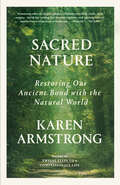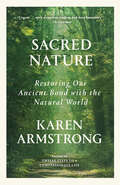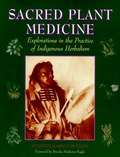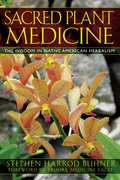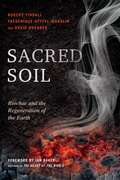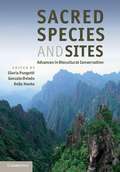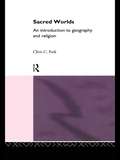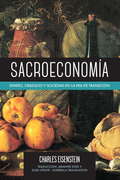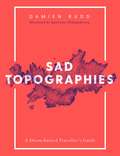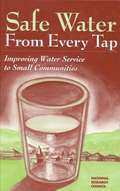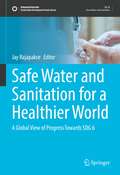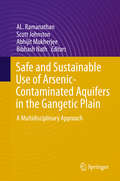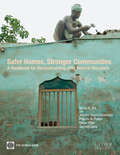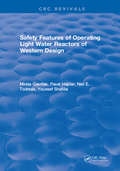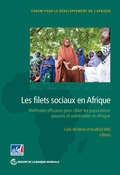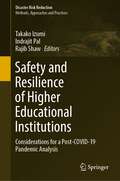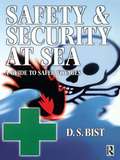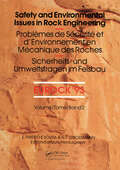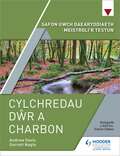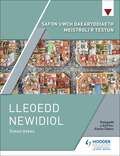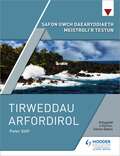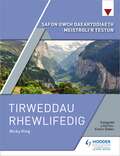- Table View
- List View
Sacred Nature: Restoring Our Ancient Bond with the Natural World
by Karen ArmstrongFrom one of the most original thinkers on the role of religion in the modern world, a profound exploration of the spiritual power of nature—and an urgent call to reclaim that power in everyday life. "Much has been written on the scientific and technological aspects of climate change.... But Armstrong&’s book is both more personal and more profound. Its urgent message is that hearts and minds need to change if we are to once more learn to revere our beautiful and fragile planet." —The GuardianSince the beginning of time, humankind has looked upon nature and seen the divine. In the writings of the great thinkers across religions, the natural world inspires everything from fear, to awe, to tranquil contemplation; God, or however one defined the sublime, was present in everything. Yet today, even as we admire a tree or take in a striking landscape, we rarely see nature as sacred.In this short but deeply powerful book, the best-selling historian of religion Karen Armstrong re-sacralizes nature for modern times. Drawing on her vast knowledge of the world&’s religious traditions, she vividly describes nature&’s central place in spirituality across the centuries. In bringing this age-old wisdom to life, Armstrong shows modern readers how to rediscover nature&’s potency and form a connection to something greater than ourselves.
Sacred Nature: Restoring our Ancient Bond with the Natural World
by Karen ArmstrongA profound exploration of the spiritual power of nature—and an urgent call to reclaim that power in everyday life.Since the beginning of time, humankind has looked upon nature and seen the divine. In the writings of the great thinkers across religions, the natural world inspires everything from fear to awe to tranquil contemplation; God, or however one defined the sublime, was present in everything. Yet today, even as we admire a tree or take in a striking landscape, we rarely see nature as sacred.In this deeply powerful book, the bestselling historian of religion Karen Armstrong re-sacralizes nature for modern times. Drawing on her vast knowledge of the world's religious traditions, she vividly describes nature's central place in spirituality across the centuries: from the Book of Job to St. Thomas Aquinas, from Lao Tzu to Wordsworth, and from the Stoics to Jainism and beyond. Throughout, she reveals how we have lost our sense of the divine, and how we can get it back.Armstrong explores the power of silence and solitude, the nature of personal sacrifice and the need to reconnect with sorrow and compassion—and how greater contact with and appreciation for nature can help us in unexpected ways. In bringing this age-old wisdom to life, Armstrong shows modern readers how to rediscover nature's potency and form a connection to something greater than ourselves.
Sacred Plant Medicine: Explorations in the Practice of Indigenous Herbalism
by Stephen H. BuhnerIn Sacred Plant Medicine Stephen Buhner examines how indigenous peoples throughout the world learned the use of plant medicines. He explores the sacred dimension of plant and human interactions--a territory where humans experience communications from plants as expressions of Spirit. Indigenous peoples were clear, and Buhner's firsthand accounts bear this out, they did not learn the uses of plant medicines through trial and error but directly from the plants themselves. Sacred Plant Medicine develops a map of the territory of plant intelligence and the human interaction with it by focusing on the earliest and most basic human form of that contact between differing intelligences. For each healing plant described in the book, he presents medicinal uses, preparatory guidelines, and ceremonial elements such as prayers and medicine songs associated with the use of the plant. Each of us can communicate with the plants and become one with them.
Sacred Plant Medicine: The Wisdom in Native American Herbalism
by Brooke Medicine Eagle Stephen Harrod BuhnerThe first in-depth examination of the sacred underpinnings of the world of Native American medicinal herbalism• Reveals how shamans and healers “talk” with plants to discover their medicinal properties• Includes the prayers and medicine songs associated with each of the plants examined• By the author of The Secret Teachings of PlantsAs humans evolved on Earth they used plants for everything imaginable--food, weapons, baskets, clothes, shelter, and medicine. Indigenous peoples the world over have been able to gather knowledge of plant uses by communicating directly with plants and honoring the sacred relationship between themselves and the plant world. In Sacred Plant Medicine Stephen Harrod Buhner looks at the long-standing relationship between indigenous peoples and plants and examines the techniques and states of mind these cultures use to communicate with the plant world. He explores the sacred dimension of plant and human interactions and the territory where plants are an expression of Spirit. For each healing plant described in the book, Buhner presents medicinal uses, preparatory guidelines, and ceremonial elements such as prayers and medicine songs associated with its use.
Sacred Soil: Biochar and the Regeneration of the Earth
by Ian Baker Robert Tindall David Shearer Frederique Apffel-MarglinA fascinating description of how utilizing the biochar embedded in terra preta, the recently rediscovered sacred soil of the pre-Columbian peoples of the Amazon rainforest, can cut our dependency on petrochemicals, restore the health of our soils, remove carbon from our overheating atmosphere, and restore the planet to pre-industrial levels of atmospheric carbon by 2050. The authors show that the rediscovery of terra preta is an opportunity to move beyond the West’s tradition of plunder and genocide of the native civilizations of the Americas by offering an invitation to embrace the deeper mystery of the indigenous methods of inquiry and to participate in an animate cosmos that gave rise to such a powerful soil technology. Sacred Soil, in recognizing the need for biocultural regeneration, takes a multi-disciplinary approach to the phenomenon of biochar soils, utilizing mythopoeic, historical, anthropological, and scientific perspectives to embrace the deep past, the vexed present, and the prospectus for our future. Coming at this crucial juncture in human history, the potential resting in biochar is also an open doorway into the indigenous ways of knowing that enabled the pre-Columbian Amazonian high civilizations to support a population of millions while leaving their lands more fertile than when they arose.
Sacred Species and Sites
by Della Hooke Gonzalo Oviedo Gloria PungettiIt is being increasingly recognised that cultural and biological diversity are deeply linked and that conservation programmes should take into account the ethical, cultural and spiritual values of nature. With contributions from a range of scholars, practitioners and spiritual leaders from around the world, this book provides new insights into biocultural diversity conservation. It explores sacred landscapes, sites, plants and animals from around the world to demonstrate the links between nature conservation and spiritual beliefs and traditions. Key conceptual topics are connected to case studies, as well as modern and ancient spiritual insights, guiding the reader through the various issues from fundamental theory and beliefs to practical applications. It looks forward to the biocultural agenda, providing guidelines for future research and practice and offering suggestions for improved integration of these values into policy, planning and management.
Sacred Worlds: An Introduction to Geography and Religion
by Chris ParkThis book, the first in the field for two decades, looks at the relationships between geography and religion. It represents a synthesis of research by geographers of many countries, mainly since the 1960s. No previous book has tackled this emerging field from such a broad, interdisciplinary perspective, and never before have such a variety of detailed case studies been pulled together in so comparative or illuminating a way. Examples and case studies have been drawn from all the major world religions and from all continents from both a historical and contemporary perspective. Major themes covered in the book include the distribution of religion and the processes by which religion and religious ideas spread through space and time. Some of the important links between religion and population are also explored. A great deal of attention is focused on the visible manifestations of religion on the cultural landscape, including landscapes of worship and of death, and the whole field of sacred space and religious pilgrimage.
Sacroeconomía
by Charles Eisenstein Susa Oñate Arianne SvedSacroeconomía analiza la historia del dinero desde las antiguas economías del obsequio hasta el capitalismo moderno, revelando hasta qué punto el sistema monetario ha contribuido a la alienación, la competencia y la escasez, ha destruido el sentimiento de comunidad y ha obligado al crecimiento ilimitado. Estas tendencias han llegado a su extremo hoy en día. Sin embargo, tras su derrumbe podríamos hallar una gran oportunidad para acometer la transición hacia un modo de ser más interconectado, ecológico y sostenible. Este libro trata de la transformación que deberá experimentar --y que ya experimenta-- el sistema monetario para encarnar dicha transición. Sacroeconomía ofrece una síntesis amplia que integra teoría, políticas y prácticas, y examina conceptos vanguardistas de la Nueva Economía, entre ellos la moneda de interés negativo, la moneda local, la economía basada en los recursos, las economías del obsequio y la restauración del procomún. El autor, Charles Eisenstein, sopesa también las dimensiones personales de esta transición, dirigiéndose a quienes aspiran a un "modo de subsistencia correcto" y a vivir en consonancia con sus ideales en un mundo aparentemente gobernado por el dinero. Recurriendo a una larga tradición de pensamiento económico convencional y no convencional, Sacroeconomía presenta una visión original a la vez que sensata, radical a la vez que moderada; una visión de creciente relevancia ante la crisis, cada vez más profunda, de nuestra civilización.
Sad Topographies
by Damien RuddSad Topographies is an illustrated guide for the melancholic among us. Dispirited travellers rejoice as Damien Rudd journeys across continents in search of the world’s most joyless place names and their fascinating etymologies. Behind each lugubrious place name exists a story, a richly interwoven narrative of mythology, history, landscape, misadventure and tragedy. From Disappointment Island in the Southern Ocean to Misery in Germany, across to Lonely Island in Russia, or, if you’re feeling more intrepid, pay a visit to Mount Hopeless in Australia – all from the comfort of your armchair. With hand drawn maps by illustrator Kateryna Didyk, Sad Topographies will steer you along paths that lead to strange and obscure places, navigating the terrains of historical fact and imaginative fiction. At turns poetic and dark-humoured, this is a travel guide quite like no other. Damien Rudd is the founder of the hugely popular Instagram account @sadtopographies.
Safe Crossing
by Kari PercivalHow does an amphibian cross the road? With the help of the Amphibian Migration Team! Learn all about a citizen scientist who acts as a crossing guard for migrating amphibians and helps build them a tunnel to safety in this delightful nonfiction picture book!From Kari Percival, Ezra Jack Keats Award-winning author of How to Say Hello to a Worm, comes an entertaining and informative children’s book perfect for curious, nature-loving young readers.Every spring, frogs and salamanders must travel from wooded uplands where they were born to vernal pools where they will mate. Unfortunately, roads constructed through their habitats have made the journey dangerous for these slow-moving animals. Many never reach their destinations. But with the help of the Amphibian Migration Team, there is hope for a safe crossing!Readers will learn so much about amphibians and their habitats and get a great introduction to civic participation, too. The citizen scientist at the heart of this story presents her proposal for a wildlife tunnel to her local City Council and coordinates with stakeholders in the process like a wildlife biologist, a herpetologist, a roadway engineer, a surveyor, the Conservation Commission, the Department of Fish and Wildlife, the Department of Transportation, contractors, and reporters. It’s a fascinating way to find out how local government works and how kids can actively create social change. Playful and educational, Safe Crossing offers an empowering example of how even the youngest citizens can raise awareness about a meaningful cause, drive change, and unite people locally and globally.BECOME A CITIZEN SCIENTIST: Citizen scientists are rallying around the world. You, too, can train to be an amphibian crossing guard! Protecting amphibians as they migrate to and from laying eggs means protecting many endangered species.CONNECTION AND CONSERVATION: Doing citizen science gives kids and caregivers a meaningful way to connect with neighbors, friends, and their local ecosystem. This book offers a powerful example of how children can make a difference by raising awareness and uniting a community around causes they care about.FASCINATING BACKMATTER: There’s so much to learn! Additional resources at the back of the book include information on amphibian life cycles, crossings, and safety, wildlife tunnels, road safety, becoming a community scientist, and a glossary. As an added bonus, the front and back endpapers feature scavenger hunts for spring peeper tadpoles, spotted salamander eggs, tiny fairy shrimp, and much more!Perfect for:Kids who love science, nature, and animalsTeachers, educators, and librarians seeking classroom books with STEM contentScout troop leaders and parents looking for engaging nature books for kidsEnvironmental activists and club leadersFans of Over and Under the Pond, We Are All Connected: Caring for Each Other & the Earth, and National Geographic Kids books
Safe Water From Every Tap: Improving Water Service to Small Communities
by Committee on Small Water Supply SystemsSmall communities violate federal requirements for safe drinking water as much as three times more often than cities. Yet these communities often cannot afford to improve their water service. Safe Water From Every Tap reviews the risks of violating drinking water standards and discusses options for improving water service in small communities. Included are detailed reviews of a wide range of technologies appropriate for treating drinking water in small communities. The book also presents a variety of institutional options for improving the management efficiency and financial stability of water systems.
Safe Water and Sanitation for a Healthier World: A Global View of Progress Towards SDG 6 (Sustainable Development Goals Series)
by Jay RajapakseThis volume presents a review of global progress made towards achieving Sustainable Development Goal 6 (SDG 6): Clean Water and Sanitation, part of the United Nations 2030 Agenda for Sustainable Development. It builds on the latest data and statistics provided by the UN and other international organizations through chapters written by a wide variety of authors, including representatives of government ministries and departments, members of international organizations specializing in this area, academics and senior professionals. The book details how SDG 6 is being approached in a number of geographic regions, with each chapter describing developments in a particular region or country. Supporting case studies presented in the book illustrate progress, achievements and challenges that remain in the effort to reach SDG 6 by 2030. The book is intended for academics/researchers, scientists, policymakers, practitioners, and all stakeholders working at the global, regional, national and local levels who support or are engaged with the implementation of SDG 6.
Safe and Sustainable Use of Arsenic-Contaminated Aquifers in the Gangetic Plain
by Scott Johnston Al Ramanathan Abhijit Mukherjee Bibhash NathThis book offers a meaningful and practicable guide to better management of arsenic problems in the groundwater of the Gangetic Plain. It gathers contributions from distinguished researchers who have been actively working in the area for over a decade. The arsenic contamination of groundwater is a growing concern in the central Gangetic Plain, where the local population's main sources of fresh water are surface water, groundwater and rain water; of these sources, only the last two generally meet the most important criteria for drinking water in their natural state. Natural geological changes are presumed to be the primary reason for arsenic contamination in this region. Further, most of the people living in this area have developed the habit of drinking water (groundwater) from the arsenic-contaminated tubewells in many parts of the region. As a result, many are suffering from arsenicosis and many more are at risk. Since the cause of arsenic contamination in groundwater still remains unclear, this book seeks to address the arsenic issue in this region by pursuing a holistic and systematic scientific approach. Accordingly, it delineates various sources, processes, hypotheses and remedial approaches that are needed to manage the arsenic contamination in the Central Gangetic Plain.
Safer Homes, Stronger Communities: A Handbook for Reconstructing After Natural Disasters
by Priscilla M. Phelps Daniel Pittet Stephen Sena Jennifer Duyne Barenstein Abhas K. JhaBest practices in post-disaster housing and community reconstruction are constantly evolving. The frequency and severity of disasters are increasing and technology is changing how reconstruction is done. Reconstruction projects must increasingly focus on the need to reduce future risks by ensuring that what is rebuilt is safer and more disaster-resilient than what was there before. The expanding role of communities in managing community reconstruction, with financial and technical assistance from government, is another way reconstruction is changing. 'Safer Homes, Stronger Communities' is a handbook that gives policy makers and project managers the information they need to plan and carry out housing and community reconstruction projects that empower communities affected by disasters and that reduce their vulnerability to future disasters. The handbook includes nearly 100 case studies collected from global experts with recent experience in housing reconstruction that illustrate how the policies and practical approaches recommended in the handbook have been used on the ground. It also includes links to extensive technical information on the topics covered by the handbook and is complemented by a Web site for practitioners in the field (http://www.housingreconstruction.org). Designed to provide immediate guidance in post-disaster reconstruction settings, 'Safer Homes, Stronger Communities' is a vital resource for policy makers and project managers, and for all practitioners involved in post-disaster housing and community reconstruction and disaster risk management.
Safety Features of Operating Light Water Reactors of Western Design
by M. GavrilasThis text arose from a study originally undertaken for the Department of Energy to characterize the principal safety features of light water reactors of western design. This text should be of use to professional engineers interested in safety assessment of operating light water reactors, students interested in the principal safety features of LWRs, and others interested in tracing the design evolution of light water reactors. However, while ambitious in its scope, this text should not be viewed as presenting the levels of reactor safety of the various families of western reactor designs.
Safety Nets in Africa
by Carlo Del Ninno Bradford MillsThe need for safety nets in Sub-Saharan Africa is vast. In addition to being the world's poorest region, Sub-Saharan Africa is also one of the most unequal. In this context, redistribution must be seen as a legitimate way to fight poverty and ensure shared prosperity - and all the more so in countries where growth is driven by extractive industries that are not labor-intensive and often employ very few poor people. Given that most African countries face difficult decisions about how to allocate limited resources among a number of social programs, evidence is important. Do Safety Net programs actually benefit the poorest people? This book demonstrates with empirical evidence that it is possible to reach the poorest and most vulnerable people with safety net programs, and provides lessons for the effective use of targeting methods to achieve this outcome in the region.
Safety and Resilience of Higher Educational Institutions: Considerations for a Post-COVID-19 Pandemic Analysis (Disaster Risk Reduction)
by Rajib Shaw Takako Izumi Indrajit PalThe world has spent the majority of 2020 enduring an unpreceded crisis caused by the COVID-19 pandemic. The impact of this crisis has been enormous, and the situation has yet to be resolved. It is still difficult to anticipate when the pandemic will end and how our lives will have changed after the crisis.Higher educational institutions (HEIs) have also had to undergo tremendous transformation, in particular, changing a conventional educational, teaching, and learning system to a digital and online mode and cancelling or postponing important events such as graduation and entrance ceremonies and entrance examinations. In addition, a number of HEIs have been facing financial constraints due to reduced enrolment, particularly from overseas. Students have missed opportunities to meet their family and friends, causing profound psychosocial impact and stress for all concerned.Simultaneously, however, the situation has given HEIs a good opportunity to consider their disaster preparedness, response, and recovery capacity on campus. Some surveys have highlighted a lack of preparedness for pandemic and other hazardous risks beyond natural hazards. Safety issues are a top priority at HEIs because they bring together a number of students, faculty, and staff.This book covers the experiences and lessons learned from HEIs in preparedness, response, and recovery during the COVID-19 pandemic to prepare for such calamities beyond natural disasters in the future. The book consists of 15 chapters divided into three major sections. They highlight the importance of HEIs’ governance issues in disaster risk management, examine the challenges that HEIs have faced during the pandemic and the implementation of new teaching and learning methodologies, and provide innovative responses and preparedness by HEIs based on science and technology, respectively.
Safety and Security at Sea
by D S BistSafety and Security at Sea is concerned with the safe operation of ships and consequently with preventing errors and oversights. This book contributes to safety where it is most effective - right at the site of work, on board the ship itself. It is here, indisputably, that it will prevent accidents and save lives. It translates theory into practice besides covering several new and current topics. This book is aimed at every deck officer - at every rank and on all ships. The book also attends to other manifest needs and discusses piracy, stowaways, management of crew on board and several other new and current topics in the interest of safety.All deck officers will find, when preparing for professional examinations, that the area which the oral section of these examinations at any level (Class One, Two or Three) cover - safety - is the one in which this book specialises. It will be an invaluable aid in passing these exams. By discussing essential details in every part of a voyage, parts that form different subjects in the theoretical section, it becomes an excellent reference book for them. In addition, it will also asist the staff of shipping companies in compiling ship operation manuals.This book includes the advice of various notices from the Marine Safety Agency and of guidelines from the International Maritime Organisation. It explains their requirements - International safety management code, emergency pollution control plans and others.In order to deal with ship board work thoroughly, this book takes an entire voyage into account. That is the reason for the sequence of its chapters to correspond to the progress of an actual voyage. The book begins with a ship embarking on a voyage and, in succession, conveys its message in a comfortable language. The last chapter leaves the reader at the beginning of another, but a safer, voyage.A summary is included at the end of each chapter.
Safety and environmental issues in rock engineering, volume 2: Proceedings / Comptes-rendus / Sitzungsberichte / ISRM international symposium, EUROCK '93, Lisbon, 21-24 June 1993, 2 volumes
by L. RIBEIRO E SOUSA; N. F. GROSSMANNState-of-the-art in science; engineering aspects of rock mechanics in the areas of safety ; environmental protection. Discusses various aspects concerning modelling in safety analysis, stability of underground structures, and the contribution of incident and accident cases to the progress of rock engineering activities. The influence of the environment is also considered, namely in heat ; mass transport, contaminant migration, and underground storage of waste; products.
Safon Uwch Daearyddiaeth Meistroli'r Testun: Cylchredau Dwr a Charbon
by Andrew Davis Garrett NagleExam board: AQA, Edexcel, OCR, WJEC/EduqasLevel: A-levelSubject: GeographyFirst teaching: September 2016First exams: Summer 2017 (AS); Summer 2018 (A-level)Master the in-depth knowledge and higher-level skills that A-level Geography students need to succeed; this focused topic book extends learning far beyond your course textbooks.Blending detailed content and case studies with questions, exemplars and guidance, this book:- Significantly improves students' knowledge and understanding of A-level content and concepts, providing more coverage of The Water and Carbon Cycles than your existing resources- Strengthens students' analytical and interpretative skills through questions that involve a range of geographical data sources, with guidance on how to approach each task- Demonstrates how to evaluate issues, with a dedicated section in every chapter that shows how to think geographically, consider relevant evidence and structure a balanced essay- Equips students with everything they need to excel, from additional case studies and definitions of key terminology, to suggestions for further research and fieldwork ideas for the Independent Investigation- Helps students check, apply and consolidate their learning, using end-of-chapter refresher questions and discussion points, plus tailored advice for the AQA, Edexcel, OCR and WJEC/Eduqas specifications- Offers trusted and reliable content, written by a team of highly experienced senior examiners and reviewed by academics with unparalleled knowledge of the latest geographical theories
Safon Uwch Daearyddiaeth Meistroli'r Testun: Lleoedd Newidiol
by Simon OakesMaster the in-depth knowledge and higher-level skills that A-level Geography students need to succeed; this focused topic book extends learning far beyond your course textbooks.Blending detailed content and case studies with questions, exemplars and guidance, this book:- Significantly improves students' knowledge and understanding of A-level content and concepts, providing more coverage of Changing Places than your existing resources- Strengthens students' analytical and interpretative skills through questions that involve a range of geographical data sources, with guidance on how to approach each task- Demonstrates how to evaluate issues, with a dedicated section in every chapter that shows how to think geographically, consider relevant evidence and structure a balanced essay- Equips students with everything they need to excel, from additional case studies and definitions of key terminology, to suggestions for further research and fieldwork ideas for the Independent Investigation- Helps students check, apply and consolidate their learning, using end-of-chapter refresher questions and discussion points- Offers trusted and reliable content, written by a team of highly experienced senior examiners and reviewed by academics with unparalleled knowledge of the latest geographical theories
Safon Uwch Daearyddiaeth Meistroli'r Testun: Lleoedd Newidiol
by Simon OakesMaster the in-depth knowledge and higher-level skills that A-level Geography students need to succeed; this focused topic book extends learning far beyond your course textbooks.Blending detailed content and case studies with questions, exemplars and guidance, this book:- Significantly improves students' knowledge and understanding of A-level content and concepts, providing more coverage of Changing Places than your existing resources- Strengthens students' analytical and interpretative skills through questions that involve a range of geographical data sources, with guidance on how to approach each task- Demonstrates how to evaluate issues, with a dedicated section in every chapter that shows how to think geographically, consider relevant evidence and structure a balanced essay- Equips students with everything they need to excel, from additional case studies and definitions of key terminology, to suggestions for further research and fieldwork ideas for the Independent Investigation- Helps students check, apply and consolidate their learning, using end-of-chapter refresher questions and discussion points- Offers trusted and reliable content, written by a team of highly experienced senior examiners and reviewed by academics with unparalleled knowledge of the latest geographical theories
Safon Uwch Daearyddiaeth Meistroli'r Testun: Tirweddau Arfordirol
by Peter StiffExam board: AQA, Edexcel, OCR, WJEC/EduqasLevel: A-levelSubject: GeographyFirst teaching: September 2016First exams: Summer 2017 (AS); Summer 2018 (A-level)Master the in-depth knowledge and higher-level skills that A-level Geography students need to succeed; this focused topic book extends learning far beyond your course textbooks.Blending detailed content and case studies with questions, exemplars and guidance, this book:- Significantly improves students' knowledge and understanding of A-level content and concepts, providing more coverage of Coastal Landscapes than your existing resources- Strengthens students' analytical and interpretative skills through questions that involve a range of geographical data sources, with guidance on how to approach each task- Demonstrates how to evaluate issues, with a dedicated section in every chapter that shows how to think geographically, consider relevant evidence and structure a balanced essay- Equips students with everything they need to excel, from additional case studies and definitions of key terminology, to suggestions for further research and fieldwork ideas for the Independent Investigation- Helps students check, apply and consolidate their learning, using end-of-chapter refresher questions and discussion points, plus tailored advice for the AQA, Edexcel, OCR and WJEC/Eduqas specifications- Offers trusted and reliable content, written by a team of highly experienced senior examiners and reviewed by academics with unparalleled knowledge of the latest geographical theories
Safon Uwch Daearyddiaeth Meistroli'r Testun: Tirweddau Rhewlifedig
by Nicky KingExam board: AQA, Edexcel, OCR, WJEC/EduqasLevel: A-levelSubject: GeographyFirst teaching: September 2016First exams: Summer 2017 (AS); Summer 2018 (A-level)Master the in-depth knowledge and higher-level skills that A-level Geography students need to succeed; this focused topic book extends learning far beyond your course textbooks.Blending detailed content and case studies with questions, exemplars and guidance, this book:- Significantly improves students' knowledge and understanding of A-level content and concepts, providing more coverage of Glaciated Landscapes than your existing resources- Strengthens students' analytical and interpretative skills through questions that involve a range of geographical data sources, with guidance on how to approach each task- Demonstrates how to evaluate issues, with a dedicated section in every chapter that shows how to think geographically, consider relevant evidence and structure a balanced essay- Equips students with everything they need to excel, from additional case studies and definitions of key terminology, to suggestions for further research and fieldwork ideas for the Independent Investigation- Helps students check, apply and consolidate their learning, using end-of-chapter refresher questions and discussion points, plus tailored advice for the AQA, Edexcel, OCR and WJEC/Eduqas specifications- Offers trusted and reliable content, written by a team of highly experienced senior examiners and reviewed by academics with unparalleled knowledge of the latest geographical theories
Safon Uwch Daearyddiaeth Meistroli’r Testun: Cylchredau Dwr a Charbon
by Andrew Davis Garrett NagleExam board: AQA, Edexcel, OCR, WJEC/EduqasLevel: A-levelSubject: GeographyFirst teaching: September 2016First exams: Summer 2017 (AS); Summer 2018 (A-level)Master the in-depth knowledge and higher-level skills that A-level Geography students need to succeed; this focused topic book extends learning far beyond your course textbooks.Blending detailed content and case studies with questions, exemplars and guidance, this book:- Significantly improves students' knowledge and understanding of A-level content and concepts, providing more coverage of The Water and Carbon Cycles than your existing resources- Strengthens students' analytical and interpretative skills through questions that involve a range of geographical data sources, with guidance on how to approach each task- Demonstrates how to evaluate issues, with a dedicated section in every chapter that shows how to think geographically, consider relevant evidence and structure a balanced essay- Equips students with everything they need to excel, from additional case studies and definitions of key terminology, to suggestions for further research and fieldwork ideas for the Independent Investigation- Helps students check, apply and consolidate their learning, using end-of-chapter refresher questions and discussion points, plus tailored advice for the AQA, Edexcel, OCR and WJEC/Eduqas specifications- Offers trusted and reliable content, written by a team of highly experienced senior examiners and reviewed by academics with unparalleled knowledge of the latest geographical theories
